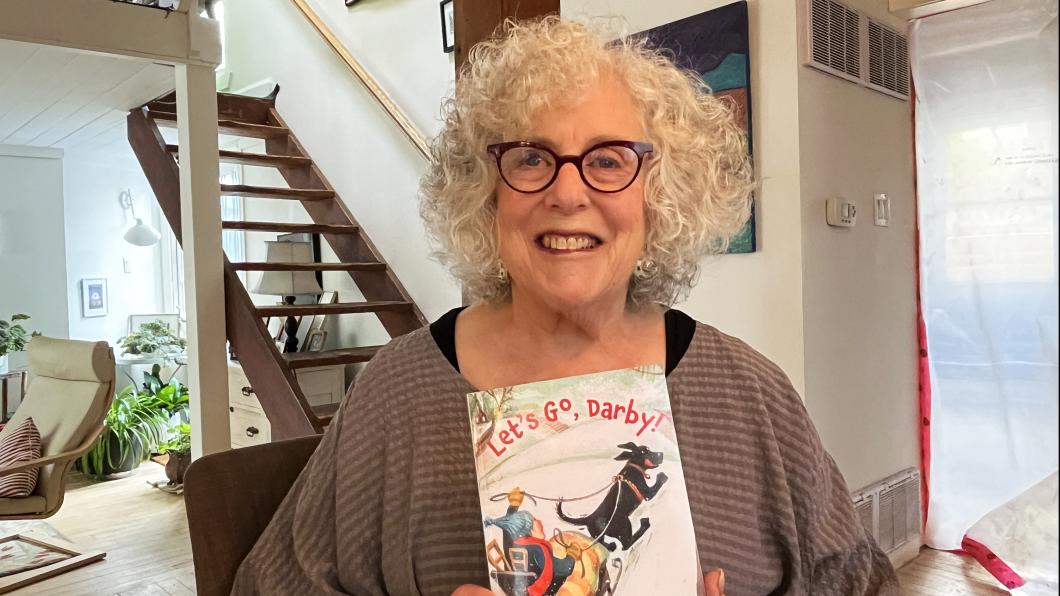
The boy who set out on dogsled to find surgery
By Louise Kinross
In 1898, a 10-year-old Uxbridge, Ont. boy set out alone on dogsled to travel 40 miles to The Hospital for Sick Children in Toronto in hopes of a surgery. Georgie Titus was his name, and his story is the basis of a new book for middle readers called Let's Go, Darby! Georgie arrived with his dog Darby at SickKids at night and spent the next seven months there, including a summer on the Toronto Island, where patients were moved for the healing effects of nature. Author Linda Rosenbaum (above), who has a son with a disability, lives on the island.
BLOOM: Why did you want to tell the story of Georgie Titus?
Linda Rosenbaum: I live on Toronto Island and the Lakeside Home for Little Children, SickKids' summer home, used to be on the island. It was a glorious Victorian building. I walked by the site often and I was always fascinated by it. The home wasn't used after 1917, so all I saw was an empty lot, but I'd seen photos and the building was magnificent.
I started reading history books about SickKids and I ran across this true story about Georgie in a book commissioned by the hospital to celebrate its first 100 years. A news story said Georgie, who was called crippled then, was desperate for an operation, so he took a dogsled all by himself from Uxbridge to Toronto and landed on the doorstep of SickKids. After seven months and several operations, he was able to walk.
It was such a remarkable story that involved such bravery that I thought I have to write about this. Club foot was a common cause of disability then, so I said he had club feet. I had a lot of research to do to fill in a backstory. Let's Go Darby is historical fiction, and I thank the real Georgie Titus for making his remarkable journey.
BLOOM: What is your connection to disability?
Linda Rosenbaum: Our son Michael was born with fetal alcohol syndrome. We adopted him at birth and he wasn't diagnosed till he was six. He was diagnosed by Dr. Wendy Roberts at SickKids.
BLOOM: Wendy also worked here at Bloorview for a long time.
Linda Rosenbaum: She was this wonderful person in our lives, so I've always had a soft spot for SickKids. I've always been sensitive to issues for kids with disabilities, and I knew in terms of children's literature, that if a character is ill or disabled, they're sidelined or absent. From my research, my book is the only middle-grade reader where all the characters are hospital patients being treated for illness or disability.
BLOOM: When Georgie was alive there was no universal healthcare. In your book, Georgie is concerned that his parents can't afford the surgery he wants for his club feet. So he takes matters into his own hands. In the real story, did the hospital raise the funds to cover the surgery and Georgie's care?
Linda Rosenbaum: Yes, they raised the funds. Georgie's parents said he could stay for treatment once they realized they wouldn't have to pay for it. The cost of care was an enormous burden for some families.
BLOOM: What do you hope children take from the book?
Linda Rosenbaum: I hope they identify with the characters and see that while they face their own particular challenges they're regular kids like everyone else. They're navigating friendships and their first love interest and how to get along with their parents and siblings. I hope it's a positive story about the power of friendship to help one another heal.
BLOOM: There's a lot of fascinating historical information about the hospital in 1898. For example, the boys’ ward had 24 beds. In the morning, they said prayers and ate stewed prunes and porridge and drank beef tea. Parents were only allowed to visit for two hours once a week.
Linda Rosenbaum: Yes, what a difference now that parents can sleep in the room with their child and kids have single bedrooms. I spent months and months in the SickKids’ archive going through historical photos and history books. The archivist was very helpful. If you're going to write a book, you have to get the details right. Once you start researching, you fall into a rabbit hole where you find everything interesting.
The biggest challenge was to get a sense of the kids’ lives. Even though I could read about patients’ illnesses and the activities they did, you don't have anything about their internal lives. The hardest part was taking all of this information and trying to develop real human beings with real feelings and relationships.
BLOOM: I was surprised to read about how many children were taken from the hospital to stay in a home on the Toronto Island in the summer. You write about how the children were dressed up in fancy clothes and rode in horse-drawn carriages in a parade down to the ferry in the summer.
Linda Rosenbaum: The home could accommodate 200 children at a time. It must have been such a relief for the children who’d been cooped up in hospital with not a lot of windows to come out to the island for the summer. I've seen photos of patients in canoes with nurses and sleeping outside in cots on a veranda.
Watch Linda talk about Let’s Go, Darby! in this CBC interview or read more about the book. Like this content? Sign up for our monthly BLOOM e-letter, follow BLOOM editor @LouiseKinross on X or @louisekinross.bsky.social on Bluesky, or watch our A Family Like Mine video series.